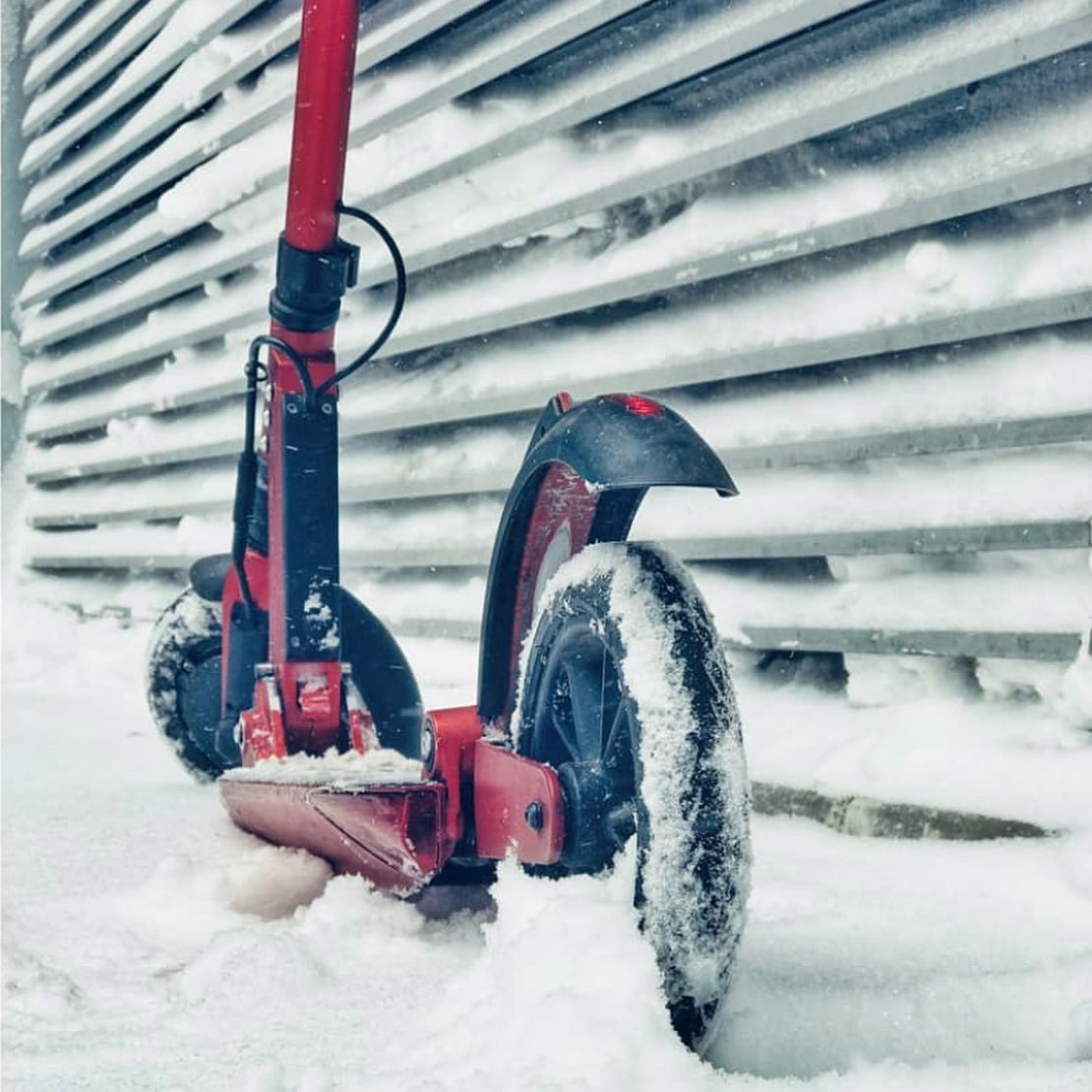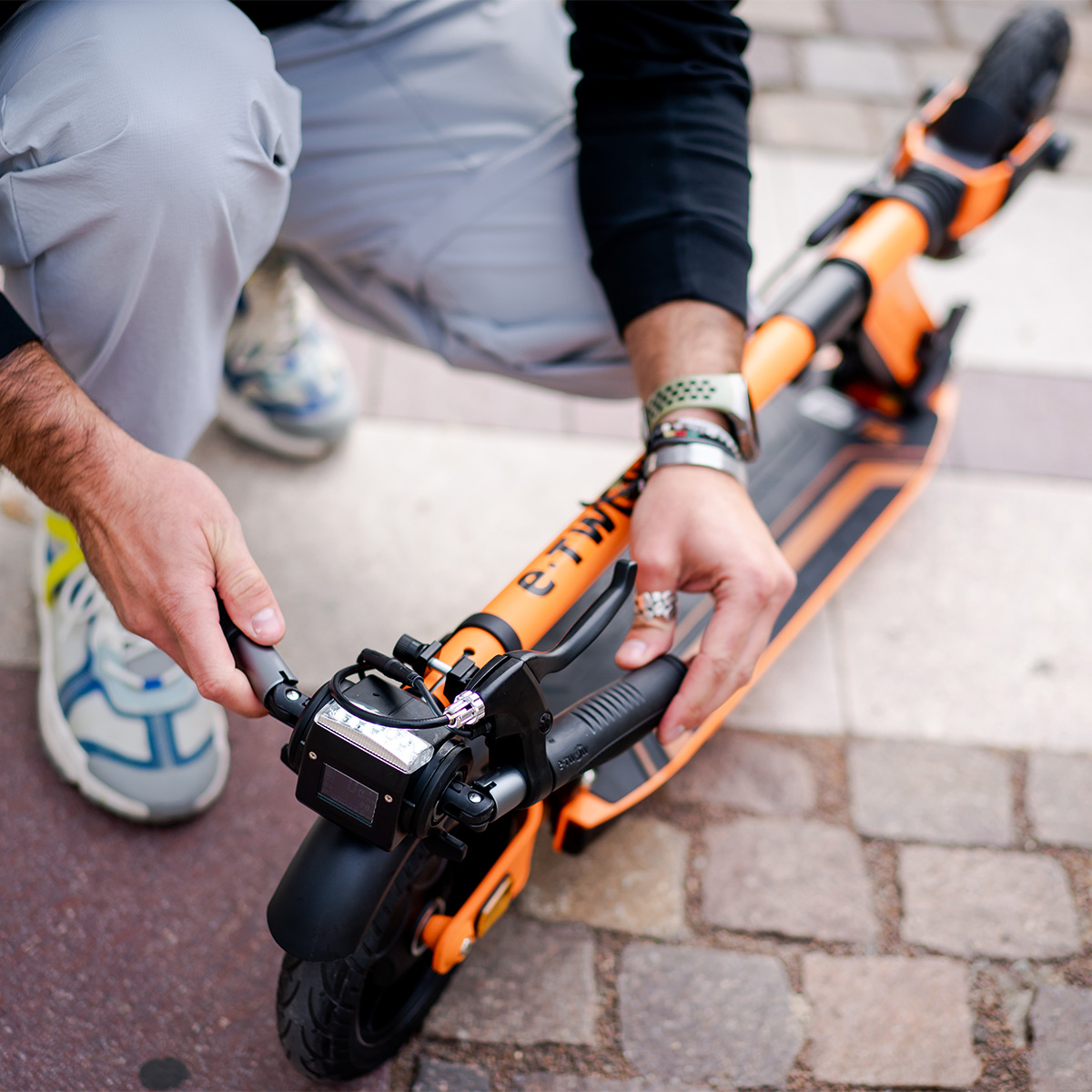No matter what part of the world you live in, the winter season officially starts when you randomly hear carols in the supermarket. The holiday season brings not only jingles and merriness but also a lot of cold-season lifestyle changes. For e-scooters users, winter can mean different things, depending on their regional climate. If this is your first winter as an e-scooter user, you probably have a lot of questions.
Can you use an electric scooter in the winter? How do you care for your electric scooter during winter? What is the proper way to store an electric scooter in winter? These are but a few of the many questions that we will answer in the following lines. We will cover everything from advice for safely using your scooter during winter, to maintenance and storage tips. Even if your scooter already has a few winters under its platform, you should keep on reading. There are several things that you can learn to protect your scooter from the damaging effects of cold weather.
 Can you ride an electric scooter in the winter?
Can you ride an electric scooter in the winter?
Whether you can ride an e-scooter during winter depends on two factors. First, you need to consider what winter looks like in your region. If you live in a warm climate where winter only brings a reasonable drop in temperature and windier days, you can keep using your electric scooter. Nonetheless, be prepared for a change in performance.
Omit, if you live in a cold climate, where winter brings frequent snowfalls or rains, you might need to give up using an e-scooter until early spring. If you insist on using a scooter during winter, you should consider whether your scooter is suitable for winter use. Riding the scooter on snow is not recommended but it can be achieved if you have good traction. Needless to say, riding the electric scooter on ice is out of the question, regardless of the scooter model.
 Is your scooter suitable for winter use?
Is your scooter suitable for winter use?
Electric devices and cold weather are never a good combination, no matter how you look at this. There are several factors that you need to consider before you take your scooter out for a winter ride:
· Battery
Cold temperatures have a significant impact on a scooter’s battery. The scooter’s range can drop by as much as 30% during wintertime. The best electric scooter for winter needs an impressive battery performance. It’s not just the size of the battery that matters here but also the BMS (battery management system). From this point of view, E-TWOW scooters are quite efficient during cold weather. They are equipped with quality batteries and a smart BMS which closely monitors and optimizes the battery’s performance.
· Tires
In most parts of the world, winter also brings slippery roads. For portability reasons, the current range of E-TWOW scooters is equipped with small, airless tires. This makes them unsuitable for slippery surfaces. We don’t recommend using our scooters on such surfaces. Pneumatic tires perform slightly better, but they aren’t that safe either. Electric scooter wheels are simply too thin to perform well in slippery conditions. Nonetheless, leave it to passionate E-TWOW scooters to improvise just so they can use their scooter all year long. Some users have installed studs/spikes to improve the traction of our airless tires. This method is not tested and approved by us, but it is better than nothing if you insist on riding your scooter on snowy roads.
· Brakes
Slippery surfaces need quality brakes. E-TWOW scooters are equipped with 2 braking systems, an electromagnetic brake, and a rear drum break. In extreme conditions, we recommend using both braking systems at the same time. If your scooter is only equipped with an electric brake, you shouldn’t use it during winter.
 Tips for riding your e-scooter during winter
Tips for riding your e-scooter during winter
If you have concluded that your scooter is suitable for winter rides, there are a few things that you must keep in mind for a safe ride.
1. Dress appropriately
It is a known fact that the temperature felt in windy conditions is lower than the actual temperature. The scientific term is called wind-chill and it causes the body to lower its temperature due to the passing of cold air. More specifically, an average speed of 25 km/h will feel like a 10°-15° drop in temperature. As such, it is important to dress accordingly. Choose thermal undergarments and wind-proof outer clothing. Pay extra attention to your extremities. Protecting your hands is essential because if they freeze you will have less control over the scooter.
2. Use quality safety equipment
You should invest in quality safety equipment all year long, but keep in mind that winter requires extra protection. More specifically, you will need a winter helmet. As we mentioned in our quick guide for safely riding the scooter during winter you need a helmet with quality padding and ventilation. You can choose a helmet with an integrated visor or combine it with separate riding goggles. Just make sure that your choice of eyewear has anti-fog properties.
3. Plan your trip according to the weather
As we already mentioned, your range will decrease by as much as 30% in winter conditions. Keep this in mind when planning your daily trips. The last thing you want is to run out of battery on a winter ride and to have to carry your scooter home. Moreover, keep in mind that the weather can be capricious during winter. Check the forecast before leaving your home to avoid being caught in a storm.
4. Protect your battery
The battery is the most expensive part of the scooter and the one that is most affected by cold temperatures. Luckily, the winter decrease in performance will go away once the temperatures return to normal. Unfortunately, other factors cause permanent damage such as water leakage. In areas where winters bring heavy rainfalls, avoid riding in the rain or through puddles. Symptoms of battery water damage include but are not limited to power-on failures, sudden turn-offs, or the inability to charge up to 100%.
Bad charging habits can also damage your battery. All batteries prefer to be charged at room temperature. As we mentioned in our summer maintenance tips, you should never charge immediately after ending a ride. This also applies to winter rides. Moreover, you shouldn’t charge the scooter if it was stored in a room with a very low temperature. As a rule, always charge the scooter in a room with a moderate temperature. Allow the scooter at least 30 minutes to adjust to the room temperature before charging it. For more battery advice, check out our tips on how to increase your scooter’s battery life.
5. Wear extra reflective gear
Visibility is always reduced during winter. This happens because there is less sunlight but in winter we also deal with snowfalls and more fog than we can handle. As such, you need to make sure that you are as visible as possible in traffic. Wear reflective clothing, install light signals on your scooter and avoid riding the scooter at night as much as possible. Your back is the most visible part of you, so you need a reflective, vest, jacket, or backpack. A helmet with led lights can also be very helpful.
6. Check your scooter regularly
Your scooter is under more stress than usual during wintertime, so it is more important than ever to check it regularly. Regular maintenance can prevent future problems and make your scooter safer to use during winter. You may also want to consider some tricks for extra protection during winter. You can add protection over the display and waterproof the scooter with silicone. These methods are not 100% effective, but they can add a layer of protection if you insist on riding the scooter during winter.
7. Clean your scooter properly
Electric scooters don’t need to be cleaned very often. However, riding in the winter requires more cleaning than usual. If it is common to use salt to melt the ice in your area, you should clean your scooter after every winter ride, because the salt can lead to rust and corrosion. Even if your scooter looks clean, wipe it with a dry cloth after each ride.
 How do you store an electric scooter for the winter?
How do you store an electric scooter for the winter?
If you have decided that your local winters are too harsh for your e-scooter, you must store it properly until your next ride. However, things are not as easy as simply putting it away until spring. Here’s what you need to know.
· Store it in the right conditions
Storing the scooter in an adequate environment can protect it from battery damage, but also rust and corrosion. In the E-TWOW user manual, we recommend storing the scooter in a dry and dark place. The room temperature should be constant ranging from 10° C to 30° C. Extreme temperatures can damage the battery. Moreover, prolonged exposure to UV rays can damage the enclosure materials. Luckily the E-TWOW scooter can be folded into a very compact shape, so you can easily find a place for storing it indoors. You can easily store it in a closet or under the bed. A basement and a garage can also work if they are heated. If you want to pack the scooter in a bag to protect it from dust or UV rays, make sure that the bag is breathable. If it’s not, it could trap moisture which could damage the scooter.
· Prepare your scooter for the winter storage
To prepare your scooter for its hibernation, you first need to clean it properly. Use a soft, damp cloth for this process. Avoid abrasive brushes and any sort of chemical cleaners or solvents. Hosing it is out of the question. After cleaning it, grease the suspension and charge it to 80%. Use a silicone-based Vaseline to grease it.
· Charge it regularly
Just because your scooter is taking a well-deserved rest doesn’t mean that you can forget about it completely. It doesn’t need much maintenance, but it would appreciate it if you charged it once a month. It is bound to lose some power during storage, so simply charge it back to 80%.
Using the scooter after the winter break
When you use the scooter for the first time after a long break, you need to be a little careful. Make sure that everything works before taking it out on the street. Check the brakes, the lights, and the folding mechanism. You also need to check if all the screws are tightened. Grease the suspension if it is dry and charge the battery completely.
In a nutshell
Like any vehicle, the e-scooter performs differently in cold weather. It is surely not made for harsh winters. However, if you live in an area with mild winters, or if you are simply way too attached to your scooter, you can use it in less-than-ideal conditions. If you don’t, make sure to store it properly.

 Is your scooter suitable for winter use?
Is your scooter suitable for winter use? Tips for riding your e-scooter during winter
Tips for riding your e-scooter during winter How do you store an electric scooter for the winter?
How do you store an electric scooter for the winter?